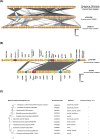Molecular characterisation of the NDM-1-encoding plasmid p2189-NDM in an Escherichia coli ST410 clinical isolate from Ghana
- PMID: 30576382
- PMCID: PMC6303030
- DOI: 10.1371/journal.pone.0209623
Molecular characterisation of the NDM-1-encoding plasmid p2189-NDM in an Escherichia coli ST410 clinical isolate from Ghana
Abstract
Global dissemination of New Delhi metallo-β-lactamase (NDM)-producing bacteria has become a major health threat. However, there are few reports regarding the identification and characterisation of NDM-producing bacteria from West Africa, including Ghana. An Escherichia coli strain with resistance to meropenem was isolated from the Tamale Teaching Hospital in Ghana. Its identification and determination of antibiotic susceptibility profile were carried out using commercial systems. The antibiotic resistance mechanism was analysed by phenotypic detection kits, PCR, and DNA sequencing. Conjugation experiments, S1 nuclease pulsed field gel electrophoresis, and Southern blotting were performed. Finally, the NDM-1-harbouring plasmid was characterised using next-generation sequencing and phylogenetic analysis. The meropenem-resistant Escherichia coli strain EC2189 harboured blaNDM-1 and belonged to sequence type 410. blaNDM-1 was located on the IncHI type transferrable plasmid p2189-NDM (248,807 bp long), which co-carried multiple resistance genes, such as blaCTX-M-15, aadA1, aac(6')-Ib, sul3, dfrA12, and cmlA1. p2189-NDM phylogenetically differed from previously identified blaNDM-1-positive IncHI type plasmids. A truncated Tn125 containing blaNDM-1 was bracketed by an ISSm-1-like insertion sequence upstream and by a site-specific integrase downstream. To the best of our knowledge, we have, for the first time identified and molecularly characterised an NDM-1-producing Enterobacteriaceae strain in Ghana with blaNDM-1 that had a novel genetic structure. Our findings indicate a possibility of NDM-1 dissemination in Ghana and underscore the need for constant monitoring of carbapenemase-producing bacteria.
Conflict of interest statement
The authors have declared that no competing interests exist.
Figures


References
-
- Yong D, Toleman MA, Giske CG, Cho HS, Sundman K, Lee K, et al. Characterization of a new metallo-β-lactamase gene, blaNDM-1, and a novel erythromycin esterase gene carried on a unique genetic structure in Klebsiella pneumoniae sequence type 14 from India. Antimicrobial agents and chemotherapy. 2009;53(12):5046–54. 10.1128/AAC.00774-09 - DOI - PMC - PubMed
Publication types
MeSH terms
Substances
LinkOut - more resources
Full Text Sources

